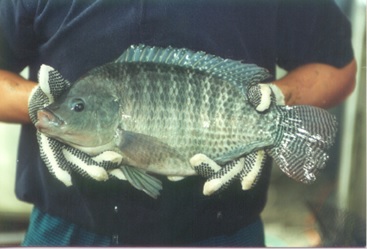Tilapia
Introduction
Belonging to the Cichlidae family, tilapia is a freshwater fish native to Africa and the Middle East. The species was first cultured approximately 4,000 years ago in Egypt and is now farmed in approximately 100 countries worldwide.
Tilapia (Figure 1) has gained popularity as an aquaculture species due to its hardiness, rapid growth rate, reproductive success and feeding efficiency on a wide range of diets.
Towards the second half of the 20th century, tilapia was introduced outside its native geographic range to several tropical, subtropical and temperate regions for the purpose of food fish aquaculture, recreational fishing, aquatic weed control and scientific research. Large-scale tilapia aquaculture production and international trade flourished in the late 1980s and into the 1990s, becoming one of the world’s dominant aquaculture species, a trend that continues to this day.

Tilapia is the second-most farmed finfish globally (second only to carps) and production is growing at 10%–12% annually, due to the excellent adaptability and low production cost of the species.
Tilapia production and consumption is concentrated in Asia where China is the world’s leading producing nation, contributing to over one‑third of global tilapia aquaculture production.
Other major tilapia-producing countries include Egypt, Indonesia, Thailand, Philippines, Brazil, Bangladesh, Vietnam, Columbia and Malaysia.
These countries primarily use production systems such as ponds and net pens to culture tilapia. In northern climates such as Canada, tilapia aquaculture requires intensive production using recirculation aquaculture systems (RAS) located in well-insulated indoor facilities with the capacity to heat water year-round.
Tilapia aquaculture in Ontario
Tilapia aquaculture in Ontario first began in 1994, when the Ontario-based aquaculture company NATI Inc. travelled to Egypt and, with the help of the Egyptian government, collected and exported tilapia from Lake Nasser to Ontario. These fish would become the founding broodstock for tilapia aquaculture in Ontario and beyond.
By 1995, tilapias from the genera Oreochromis, Sarotherodon, and Tilapia were added to Ontario’s eligible aquaculture species list, and tilapia were made available for commercial culture across the province.
Black Nile tilapia (Oreochromis Niloticus) is the most cultured tilapia species in Ontario due to its rapid growth rate. Black Nile tilapia are cultured in mono-sexed male populations to avoid unwanted maturation and reproduction.
In Ontario, tilapia aquaculture production has historically been targeted for sale into large urban live markets where price premiums can be attained. The Greater Toronto Area (GTA) is recognized as one of the largest markets for live tilapia sales in North America. Additionally, tilapia is a popular species used in aquaponic production systems.
Since 2010, domestically produced fingerlings have no longer been available in Ontario and are typically imported from the U.S. as certified, disease-free fingerlings (0.25 g).
Farming conditions for tilapia
Tilapia is a hardy species with an extremely adaptable physiology, allowing for successful culture in a wide range of aquaculture production systems and varied growing conditions. The species has been given the nickname “aquatic chicken” because of its rapid growth rate, minimal feed requirements, diverse diet and ability to produce excellent protein yields.
As an omnivorous species, tilapia can be fed a diet consisting of vegetable ingredients and limited to no animal protein ingredients.
In recirculating aquaculture systems (RAS), tilapia can grow from an initial weight of 0.25 g to live market size (680–793 g) within a short production cycle of approximately 8–9 months.
Tilapia experience optimal growing conditions when cultured at water temperatures ranging from 25°C–30°C and have the greatest success at 28°C. Additionally, tilapia should avoid cold water conditions, as water temperatures below 20°C result in loss of appetite, growth and greater onset of disease. When water temperatures fall below 16°C, tilapia stop feeding. When conditions drop below 12°C, mortality can occur.
The species has a relatively high tolerance for low oxygen levels when compared to cold water species and performs optimally in RAS when dissolved oxygen is maintained between 5–8 mg/L. In recirculating aquaculture systems (RAS), when using supplemental oxygen, stocking density can be maintained up to 100 kg/m3.
Adult tilapias are notorious for their low fecundity and relatively large egg size, reaching sexual maturity at approximately 150–250 g. Typically, spawning in most tilapia species occurs optimally when water temperatures range from 25°C–30°C.
Species outlook
Tilapia aquaculture can be challenging in northern regions such as Ontario that possess cold-water resources and climatic conditions.
Producers in the province fare best when targeting niche markets and price premiums for this species. Additionally, tilapia can be a complementary species for aquaponic production.
References
Beamish, F.W.H. 1970. Influence of Temperature and Salinity Acclimation on Temperature Preferenda of the Euryhaline Fish Tilapia nilotica. University of Guelph. 1209-1214.
El-Sayed, A.F.M. 2006. Tilapia Culture: Second Edition. Academic Press. 1-358.
Fitzsimmons, K. 2000. Future trends of tilapia aquaculture in the Americas. The World Aquaculture Society. 2(252-264).
Josupeit, H. 2004. World Market of Tilapia. INFOPESCA.
Prabu, E., Rajagopalsamy, C.B.T., Ahilan, B., Jeevagan, I.J.M.A., and Renuhadevi, M. 2019. Tilapia — Annual Research & Review in Biology. 31(3):1-14.
Watanabe, W.O., Losordo, T.M., Fitzsimmons, K., and Hanley, F. 2002. Tilapia Production Systems in the Americas: Technological Advances, Trends, and Challenges. Reviews in Fisheries Science. 10(3-4):465-498. DOI: 10.1080/20026491051758.
Author credits
This fact sheet was authored by Madeline Borland, MSc., aquaculture literature research assistant, and reviewed by Michael McQuire, aquaculture and aquaponics specialist, Ministry of Agriculture, Food and Rural Affairs. Special thanks to Gary Chapman, NATI Inc. for his contributions.
ISSN 1198-712X, Published December 2023.